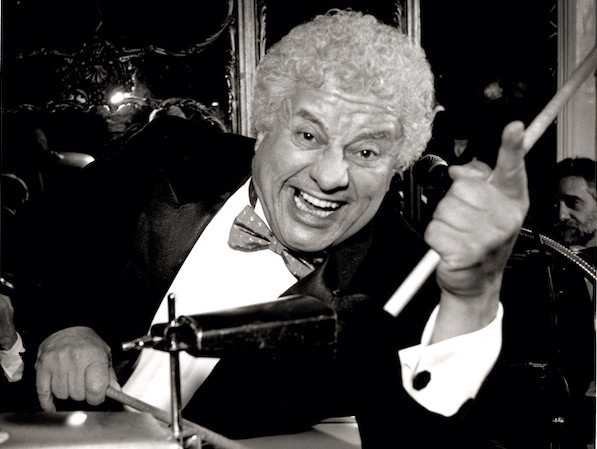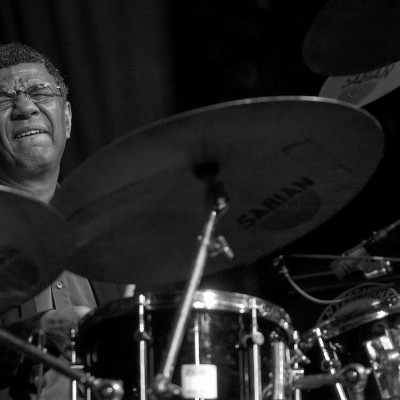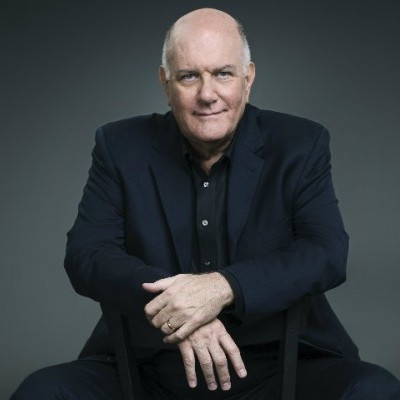Oct 28, 2025 10:47 AM
In Memoriam: Jack DeJohnette, 1942–2025
Jack DeJohnette, a bold and resourceful drummer and NEA Jazz Master who forged a unique vocabulary on the kit over his…

“Tito’s charisma, along with the rhythmic interaction and melodic interaction — everything was so fine, so exquisite,” said percussionist Giovanni Hidalgo.
(Photo: Teri Bloom)When percussionist Giovanni Hidalgo speaks about Tito Puente, he spins out a flood of examples of his mentor’s accomplishments. These include stories highlighting the bandleader’s extraordinary technique, big-hearted generosity and ability to write complex arrangements, “like you would eat ice cream.” Ultimately, he said playing in Puente’s Golden Latin Jazz All Stars during the 1990s was like being invited to join a league of superheroes.
While Puente has yet to join the Marvel Universe, his induction into the DownBeat Hall of Fame by the Veterans Committee is one more illustration of his musical immortality. At the time of his death 25 years ago (at the age of 77) he had recorded more than 120 albums and typically played 200 concerts a year. Popular worldwide for his mastery of such Latin idioms as the mambo and guaguancó, Puente never rested on his exalted status.
Along with the global acclaim, Puente embodied as much complexity as the rhythms he played. An irrepressible showman who joked and mugged onstage up until the end of his life, the bandleader was also a tough taskmaster as well as a serious, and prolific, composer. A Puerto Rican cultural hero, Puente embraced musical influences from all over the world. While Puente was comfortable in prestigious concert halls, large music festivals and the White House, he sounded equally enthused playing to kids in New York City barrios.
Born Ernesto Anthony Puente in that city in 1923, he grew up in Manhattan’s Spanish Harlem. He absorbed classical piano and jazz drumming while also being noticed as a ballroom dancer. As Latin bands thrived in the city, Puente played drums with Machito’s Afro-Cubans and Johnny Rodriguez’s Stork Club Orchestra while he was a teenager. During Puente’s time with Machito, he brought the timbales to the front of the stage where they would remain throughout his life.
United States Navy service during World War II also shaped Puente’s path. That education came amid strenuous circumstances: Along with playing alto saxophone, clarinet and bugle, he was a machine gunner on an aircraft carrier. Through the G.I. Bill, he studied composition theory at Juilliard after the war. Another post-war experience also inspired him. Because of a delay in troop movements, Puente spent time across the Pacific studying Asian music. These countries’ distinctive melodic ideas are clear in such songs as “Hong Kong Mambo” from his 1957 album Dance Mania and in subtler ways that impacted his music and consequently wound up exerting a wide influence, according to drummer Bobby Sanabria, who worked with Puente in the 1990s. “Tito was one of the first to use voicings in fourths,” Sanabria said. “That came from his exposure to Asian music. Tito modernized the way we arrange through his progressive jazz technique.”
Upon returning to New York stages in the late 1940s, Puente was a key part of the mambo rage at such clubs as the Palladium Ballroom. His command of Afro-Cuban rhythms, mixed with original ideas and an unstoppable exuberance, put Puente at the forefront among such fierce bandleaders as Machito and Tito Rodriguez. Puente told author Steven Loza in the book Tito Puente and the Making of Latin Music that while Dizzy Gillespie’s adoration of Latin rhythms are well known, Charlie Parker and Dexter Gordon also jammed with his group at the Palladium.
Discerning listeners would have heard how Puente reflected the swing drummers he admired, particularly Gene Krupa. But Puente also originated a distinctive approach. This included playing cascara rhythm patterns with his right hand and the two-bar clave with his left. He also began recording singles with various singers in 1949 (these were compiled on CD on the exceptional series Tito Puente: The Complete 78s). His expansive 1950s albums on RCA featured striking modern arrangements for Puente Goes Jazz (1956) and Night Beat (1957). One bold session, Revolving Bandstand (1960), is an orchestral call-and-response between his ensemble and Buddy Morrow’s.
During the 1960s and ’70s Puente became known as The King of Salsa, even as he derided that term as musically vague. Audiences especially adored his collaborations with that genre’s queen, Celia Cruz. He also enjoyed big crossover success in 1971 when Santana turned his “Oye Como Va” into a rock hit.
Puente’s comic timing equaled the seriousness of his music. He even became a cartoon character, appearing on “The Simpsons” in 1995. His set at Florida’s Clearwater Jazz Holiday eight months before his passing exemplified Puente as both goofily exaggerated ringmaster and demanding bandleader.
As Hidalgo said, seeing Puente perform up close meant embracing his total persona — and the entire package endures.
“Tito’s charisma, along with the rhythmic interaction and melodic interaction — everything was so fine, so exquisite” Hidalgo said. “All of us had a unique style, and when that is put together, it’s an example for people around the planet on how to be together and respect us not only as a group, but a family.” DB

Jack DeJohnette boasted a musical resume that was as long as it was fearsome.
Oct 28, 2025 10:47 AM
Jack DeJohnette, a bold and resourceful drummer and NEA Jazz Master who forged a unique vocabulary on the kit over his…

Always a sharp dresser, Farnsworth wears a pocket square given to him by trumpeter Art Farmer. “You need to look good if you want to hang around me,” Farmer told him.
Sep 23, 2025 11:12 AM
When he was 12 years old, the hard-swinging veteran drummer Joe Farnsworth had a fateful encounter with his idol Max…

D’Angelo achieved commercial and critical success experimenting with a fusion of jazz, funk, soul, R&B and hip-hop.
Oct 14, 2025 1:47 PM
D’Angelo, a Grammy-winning R&B and neo-soul singer, guitarist and pianist who exerted a profound influence on 21st…

Kandace Springs channeled Shirley Horn’s deliberate phrasing and sublime self-accompaniment during her set at this year’s Pittsburgh International Jazz Festival.
Sep 30, 2025 12:28 PM
Janis Burley, the Pittsburgh International Jazz Festival’s founder and artistic director, did not, as might be…

Jim McNeely’s singular body of work had a profound and lasting influence on many of today’s top jazz composers in the U.S. and in Europe.
Oct 7, 2025 3:40 PM
Pianist Jim McNeely, one of the most distinguished large ensemble jazz composers of his generation, died Sept. 26 at…